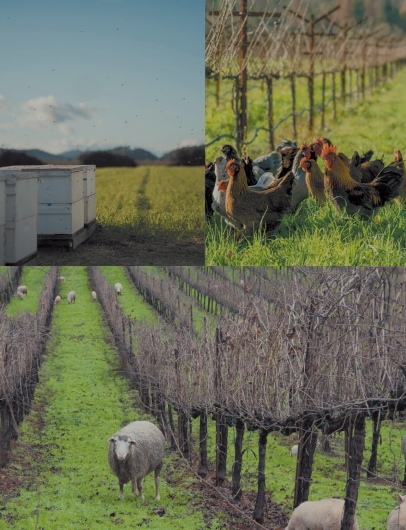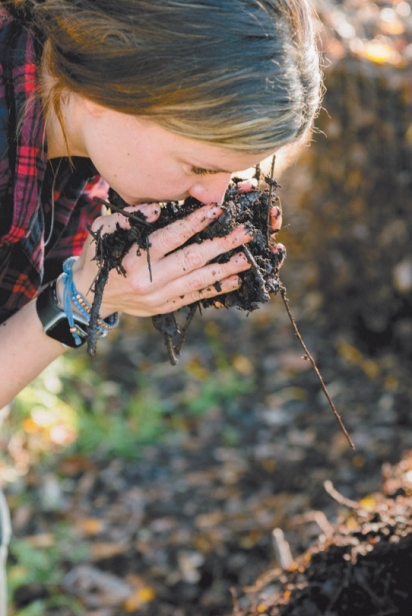If Not Here, Then Where?
RAISING THE BAR BEYOND SUSTAINABILITY TO REGENERATION IN THE VINEYARDS OF CALIFORNIA WINE COUNTRY
For years, “sustainability” has been the aspirational buzz word thrown around various industries, from lumber to ranching to viticulture, and well beyond. Recently, consecutive years of massively destructive wildfires and other natural disasters, as well as the furthering of our understanding of global climate change, have made it clear that it is no longer enough merely to sustain the status quo; if humankind is to continue to thrive in a world that appears each year to be increasingly impacted by global climate change, a transition toward practices that are truly regenerative must be undertaken.
Fortunately, a handful of key players in our region’s world-renowned wine industry are leading the way in regenerative viticulture.
Many of the existing practices included under the “sustainable” agriculture protocols are also required under the regenerative regimen, but fully regenerative practices are significantly more involved than anything previously undertaken on any sort of scale.
For many years, Napa Green has been a leader in facilitating sustainability certification for grape growers and vintners. Originally operating as a program under the auspices of the Napa Valley Vintners organization, Napa Green became an independently operated nonprofit in 2019, with a goal of continuing to grow its “certified sustainable” membership and further elevate the standards of responsible viticulture in Napa County.
More recently, Napa Green has begun transitioning participating member grape growers to its new Napa Green Vineyard Certification. The tag line for this new initiative is “Regenerating Carbon, Climate and Community.” The “community” signifies that the certification checklist includes not just land practices, but also includes calls to action on many of the social issues that face today’s diverse farm and farmworker communities. In fact, the organization’s website includes the clear policy statement: “We cannot have environmental or economic sustainability without social sustainability.”
Ambitious goals, yes. And how much impact can one voluntary membership-based organization have? Napa Green acknowledges that the Napa Valley is only 30 miles long, producing only 4% of California’s wine grapes and representing far less than 1% of the world’s wine production. “We recognize that our wine region cannot solve climate change or social inequities, but we have a powerful leadership platform. Our commitment to sustainability sets a standard that is recognized by the global wine industry, beverage sector, and beyond,” the organization states on its website.
It is true that for such a small geographic area, Napa’s influence on the global wine markets is immense, and the direct implication is that if Napa can do it, then so can the wine industries in Sonoma County, the Columbia Valley, the Finger Lakes and wine growing regions around the United States—and the globe. By extension, if the wine industry can do it, then so can those who grow corn and soybeans, cattle ranchers, chicken farmers and all types of other agriculturalists. These efforts have to start somewhere, and Anna Brittain, executive director of Napa Green, believes that Napa County is that place.
“This is a question of ‘if not here, where?’” says Brittain. “Napa County can and should be the industry leader in sustainability and climate action, including regenerative farming. Our region and wines capture global attention, meaning our leadership can be an outsized force for change. If we can unify regional vintners and growers, we can serve as a force to transform the global wine industry. That is my ultimate goal.”
The former Napa Green Land program, once the organization’s main initiative to “entice” farmer and vintner buy-in on sustainable practices, eventually became a compliance requirement. As more and more growers embrace sustainable practices, the bar is being raised to include those practices that successfully begin to bridge the gap between sustainability and regeneration.
Napa Green’s new benchmark, the Napa Green Certified Vineyard, is intended to encourage growers to continue their efforts and to embrace regenerative “carbon farming” practices. To achieve Napa Green’s new certification, growers must commit to implementing more than 100 practices organized under the following six elements—some of which are already a part of Napa Green’s best practices for sustainability.
• Element One: Social Equity, Justice and Inclusion
• Element Two: Carbon Farm Plan and Regenerative Agriculture. (For an explanation of “carbon farming” and the carbon sequestration potential of agricultural practices, we suggest https://climatechange.ucdavis.edu/climate/definitions/carbon-sequestration.)
• Element Three: Irrigation Assessments and Water Efficiency
• Element Four: Tree/Forest Preservation and Enhancement
• Element Five: Prohibited and Restricted Pesticide List
• Element Six: Conservation Burning and Burn Alternatives
As of the end of 2021, 47 members had enrolled, committing to transition to the new Napa Green Vineyard Certification. These growers account for a total of over 6,450 acres of planted land, comprising nearly 15% of the vineyards in Napa County. This is a whole-property certification, and these early participating growers collectively manage over 15,000 acres of land, including forest and wooded areas. Brittain states that these numbers are “great news,” but quickly adds that, of course, the goal is to add even more, as quickly as possible.
A small group of fast-acting members of the program expect to have their certifications in hand by the time this issue of Edible Marin & Wine Country hits the stands in March, including Oakville’s Opus One, St. Helena’s Spottswoode and Clif Family, Rutherford’s Sequoia Grove and Yountville’s Dominus. The other 42 producers are hot on their heels. Beginning with five producers who represent four separate AVAs bodes well for the program, and for Napa Green’s overall ability to appeal to a diverse array of growers. As time goes by, the pressing need for everyone to do their unique part to combat not only global climate change but also rampant social inequities is becoming more and more pronounced, and Napa Green provides a framework and support for doing both.
“The carbon farm plan, an essential part of the Napa Green certification, allows us to quantify the carbon we sequester through regenerative and dry farming, cover crops, appropriate cultivation and sheep grazing,” explains Tod Mostero, director of viticulture and winemaking at Dominus. “This provides credibility to our sustainable farming practices and holds us accountable.”
“Global responsibility is a pillar of our vision at Opus One,” says Nathalie Buckland, the superstar winery’s director of viticulture. “Vineyards are responsible for a significant percent of wine quality, so it is fitting that we focus on them to protect the environment and future of our children and our industry.”
“The new Napa Green Certification Program allows us to make a measurable impact,” says Linzi Gay, general manager of Clif Family Winery and Farm. “Clif Family was fully on board with the revamped program as it addresses so many critical issues in our industry including climate action, regenerative farming and social equity.”
“We have always supported the Napa Valley Vintners organization and Napa Green, and with Napa Green now putting forth such a dynamic and comprehensive certification that is very much aligned with our own ideologies, we wanted to very quickly support them and pursue the certification,” says Aron Weinkauf, winemaker and vineyard manager at Spottswoode Estate Vineyard and Winery.
“We also hope that many more will adopt it, and think that it will be a great thing for the entire Napa County, and wine industry.”
It’s true that Spottswoode has long been a leader in sustainable and regenerative practices. A quick glance at their web page under “One Earth” reveals a raft of certifications that signify the winery’s commitment to everything from biodynamic practices to solar power to carbon sequestration and much, much more. “The reality was that we have already been doing a lot of this anyway and for years now,” Weinkauf says, adding “What Anna [Brittain] has done with the current program is quite impressive.”
Not surprisingly, the incredible attention to detail and tremendous efforts necessary to meet the high standards set by Napa Green for this new vineyard certification are in no way inconsistent with what it takes to produce wines of the highest quality. Recently, Wine Spectator placed Dominus Cabernet Sauvignon 2018, with a score of 97, as the number one wine on their Top 100 list for 2021. Wine Advocate and Jeb Dunnuck both gave the 2018 Spottswoode Estate Cabernet Sauvignon scores of 100 points. Opus One’s 2010 garnered 97 points from Antonio Galloni, who called the wine “flatout gorgeous.” Sequoia Grove’s single-vineyard Cabernets average a lofty 4.5 star rating on Vivino, while Clif Family’s organic farm has captured the attention of Martha Stewart, Oprah and the New York Times. The accolades awarded these five producers alone could fill volumes, making it clear that they sacrifice nothing in the way of quality on behalf of their commitment to regenerative practices and social equity.
As the old adage goes, the best time to plant a tree was 20 years ago, and the second-best time is today. As Wine Country vintners and grape growers look toward the future, and to handing off their legacies to the next generations, leaving the world a better place than when they found it—or, it must be acknowledged in the face of climate change, even a viable place to continue living—seems to be for many the highest priority.
“Leading in sustainability is our duty, to forge a path of action toward the thriving environment we leave to our children,” says Mostero. Gay agrees: “Our industry has been hit hard in the past five years with fires, drought and other climate impacts. We have to all work together to act now to help mitigate the impacts of climate change for future generations.”
Making the commitment to third party certification takes time and effort, but it is worth it to demonstrate our commitment to the community and to protect our watershed, our land and the air we breathe.
- Susan Boswell, Chateau Boswell Winery


